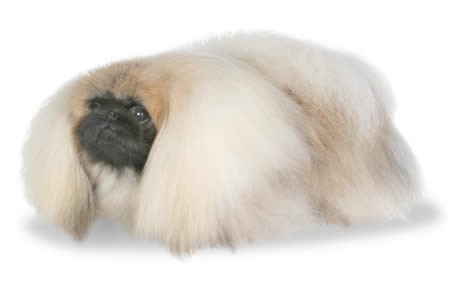Pekingese Breed Guide

Breed Group:
Companion Dogs
Get 30% off
Join our Newsletter
Sign Up Today
Pekingese Information & History
The Pekingese dog breed is an ancient toy breed hailing from China. Bred for centuries by nobles and commoners alike, the Pekingese was revered for its resemblance to a lion. The lion was closely linked to Lamaist Buddhism, and consequently so too was the Pekingese. The similarity to a lion was accentuated through centuries of dedicated breeding programs, resulting in the distinctive physical characteristics of this breed. The Pekingese breed was not only bred for appearance, but also for size. The smallest of the breed referred to as “sleeves”, were the most prized. These Pekingese served as guard dogs that were literally stuffed into the sleeves of nobility, hence their name. By the 1800’s Pekingese breeding programs were an official program of the Imperial government. The most widely revered featured prominently in artistic works by Imperial court artists.
The first five Pekingese to be brought to England were the result of British military action in Beijing. In 1860 the Imperial Summer Palace was sacked and looted, during which British military forces took five of the most prized of the breed. Upon presentation to Queen Victoria, English breeders took an increasing interest in this dog, resulting in high demand over the later half of the 19th century.
Pekingese Temperament & Personality
The Pekingese breed has unique personality traits to go along with their looks. They are regarded as an intelligent and independent breed that is above all regal in both carriage and personality. This is no surprise given their long history is revered and treated as royalty. Their intelligence and regal nature give rise to stubbornness; Pekingese love to get their way. They can showcase a playful and affectionate personality around family but seem cold and aloof with strangers. The Pekingese will tolerate other animals, and their temperament complements that of cats very well as they both tend to leave the other alone. In temperament and personality, the Pekingese is truly distinct from other toy breeds, having a carriage and disposition fitting a much larger breed.
Training a Pekingese
The Pekingese is almost universally recognized as a difficult breed to train. They are often stubborn and obstinate, so although they may understand your commands perfectly well, they may just not feel like performing the required action. The best tips for training a Pekingese are to start when they are young and have a lot of patience and time. It is important to remember that the Pekingese can be trained. Pekingese can often be found in obedience and agility competitions. That being said, this is not an easy breed to train, so first-time dog owners might want to consider a different breed. With the Pekingese, it will be important to use positive reinforcement to reward good Pekingese behavior, as scolding or punishment will result in even more stubbornness. Lastly, be sure to socialize your Pekingese at a young age to ensure that they are friendly with strangers and other animals alike.
Exercise Requirements for a Pekingese
Pekingese are a low energy, small sized breed, so they have very low exercise requirements. Your Pekingese will be perfectly content with a short daily walk around the block. Alternatively, it is a good idea to have a daily play session that incorporates training techniques. This can help alleviate some of the difficulty in training your Pekingese, while still providing exercise. It should be noted that Pekingese have a very low tolerance for heat, so owners in hot or humid climates should consider this when taking their dog for a walk or for a play session.
Pekingese Lifespan & Longevity
As one of the healthiest purebred dog breeds, a Pekingese lifespan is relatively long. Pekingese life expectancy ranges between 13-15 years on average, with many living longer.
Pekingese Breed Popularity
The Pekingese is admittedly one of the less popular toy breeds. Currently, the 93rd most popular AKC breed, the Pekingese’s lukewarm popularity most likely has to do with their stubborn nature and a personality that is off-putting to some. Most people that desire a toy breed in their house also look for a personality that is open and friendly towards all, while also being intelligent and malleable. While the Pekingese breed is certainly intelligent and is friendly towards their family, they are by no means considered affable with all strangers. Their stubborn nature also makes them difficult to train for any owner, and many first-time dog owners wanting an easy entry into dog ownership should probably look elsewhere.
Pekingese Feeding Requirements
The Pekingese does not have any unique dietary needs. To ensure a healthy coat and long life, it is recommended that you feed your Pekingese a good quality food that is appropriate for a breed their size. Look for food that contains a good balance of high-quality proteins, vegetables, and fats. Avoid foods that contain grain fillers such as soy, corn, and wheat, as these can be difficult to digest and cause allergies. Pekingese weigh between 6-14 lbs, so expect to feed your Pekingese between 2/3 and 3/4 cups of dry food a day, split into two even meals.
How to Groom a Pekingese
The unique coat of the Pekingese will require frequent brushing to avoid matting and maintain their charming good looks. The Pekingese has a fluffy outer coat and a soft undercoat that should be brushed every couple of days. For optimal Pekingese health, owners will also need to clean their over-nose wrinkle on a daily basis to avoid infection.
Are Pekingeses Good with Children?
Pekingese can be good with children that are in their family and if they have been raised around them. Children that play with them should be taught to respect their small size, as they can be easily hurt with rough play. That being said, this is not the ideal breed for a playmate for children. Their low energy and independent nature will result in them snoozing their day away on the couch more often than actively engaging in play.
Pekingese Health Issues
Brachycephalic Airway Syndrome: Brachycephalic airway syndrome refers to a variety of physiological malformations that obstructs the airway and causes difficulty breathing. Specific breeds are referred to as brachycephalic, such as the Pug and Pekingese because they have been bred to have features such as a very short muzzle. The physiological formations most commonly seen in brachycephalic breeds are stenotic nares, everted laryngeal saccules, and an elongated soft palate. Of these, stenotic nares are most commonly found in Pekingese. Stenotic nares are a condition where the nostrils of the dog are narrowed and collapse inward during inhalation. This results in difficulty breathing and can be exacerbated during rigorous exercise or play. Stenotic nares can only be corrected surgically, and treatment is often only undertaken if the condition is severe. Signs of stenotic nares are difficulty breathing, noisy breathing, snoring, and sometimes coughing or snorting following exercise. If a Pekingese with stenotic nares is over-exercised in hot or humid weather, they may collapse due to lack of air.
Keratoconjunctivitis sicca: Commonly called “dry eye”, this Pekingese eye problem results from an inadequate production of tears. This allows the cornea and surrounding tissue to become exposed to dust and debris, leading to significant irritation and redness. Signs of dry eye include a thick, yellow discharge around the eye, redness and irritation, and a dull appearance to the eyes. Chronic dry eyes can lead to damage to the eye, such as ulcers, corneal scarring, and conjunctivitis. Dry eye most commonly affects middle-aged and older dogs. Pekingese are known to be commonly affected by this condition, so it is important to check your dog’s eyes during grooming sessions to look for any abnormalities. This condition is generally treated by medication placed into the affected eyes that aids in tear production and helps protect the eye. In severe cases, surgical intervention is sometimes undertaken.
Patellar Luxation: Patellar luxation is a condition that predominantly affects miniature and toy breeds, and is commonly seen in Pekingese. With this Pekingese health problem, the kneecap (patella) becomes dislocated from the groove it rides in along the femur. This dislocation is often spontaneous and extremely painful. Signs of patellar luxation are sudden lameness in a foreleg, an inability or reluctance to place weight on a foreleg, or repeated shaking of a limb. Patellar luxation most often occurs during exercise or play but can happen at any time in dogs that are predisposed towards it. If your dog exhibits any of the signs of patellar luxation during or following exercise, be sure to consult with a veterinarian regarding treatment.
Intervertebral Disc Disease (IVDD): IVDD is a condition that results in a rupture of one or more of the discs that reside in between the bones of the spine. These discs provide padding and support for the bones and fulfill a critical function in mobility and movement. Breeds with IVDD are more likely to experience a ruptured disc. The Pekingese is one of these breeds. An onset of disc rupture generally happens between 3-6 years of age. Signs that your Pekingese has suffered a ruptured disc are a wobbly or unsteady gate and pain in the back or neck. Extremely severe ruptures sometimes result in loss of motor function in the hind legs or the inability to control bladder functions. If you suspect your Pekingese has ruptured a disc in their spine, it is extremely important to have a diagnosis performed by a veterinarian immediately to avoid any permanent nerve damage or loss of mobility. Treatments for IVDD vary from anti-inflammatories and rest to surgical intervention depending on the severity of the case.
Corneal Ulcers: Corneal ulcers are a condition where the outer layer of cells on the cornea are damaged. Because the cornea is made up of mostly nerve cells, this damage is extremely painful. Corneal ulcers are often the result of trauma, such as rubbing of the eye against an abrasive surface such as fabric or carpet, or damage from other animals. The outer layer of cells that line the cornea also provide a protective function, so corneal ulcers can lead to infection. In minor cases, corneal ulcers heal within a few days to a week. These types of superficial ulcers are often treated with antibiotic eye drops to help reduce the risk of infection. In more complicated cases, the outer layer of the cornea will not bond to the inner layers during healing, requiring more aggressive treatment. This treatment can take the form of medication or therapy, depending on the severity of the case and how long the ulcer has persisted.
Other Resources
national breed website: The Pekingese Club of America
rescues: Pekingese Charitable Club
Health Issues Associated with this Breed:
- Anxiety
- Brachycephalic Syndrome
- Cataracts
- Cleft Palate
- Cryptorchidism
- Distichiasis
- Ectopic Cilia
- Elbow Dysplasia
- Entropion
- Exposure Keratopathy Syndrome
- Fold Dermatitis
- Hip Dysplasia
- Hydrocephalus
- Inflammation
- Intervertebral Disc Disease (IVDD)
- Keratoconjunctivitis Sicca
- Mitral Valve Disease
- Pain
- Patellar Luxation
- Periodontal Disease
- Progressive Retinal Atrophy (PRA)
- Separation Anxiety





